Table of Content
Blog Summary:
This blog explains the key differences between Generative AI and Machine Learning in a simple way. Machine Learning helps make predictions and automate tasks using data, while Generative AI creates new content like text, images, and videos. You’ll learn where each technology is used, how they work, and which one fits your business needs better.
Table of Content
Before discussing its growth, it’s important to know the fundamental difference between Generative AI vs Machine Learning. Both are revolutionizing industries such as retail, healthcare, finance, logistics, etc., but they work differently and have different uses.
While machine learning is about learning from experience to predict or automate something, generative AI takes it further, generating completely new content in the form of text, images, videos, etc.
According to the latest market studies, the global machine learning market is expected to reach over $225 billion by 2030, at a CAGR of 36.2%.
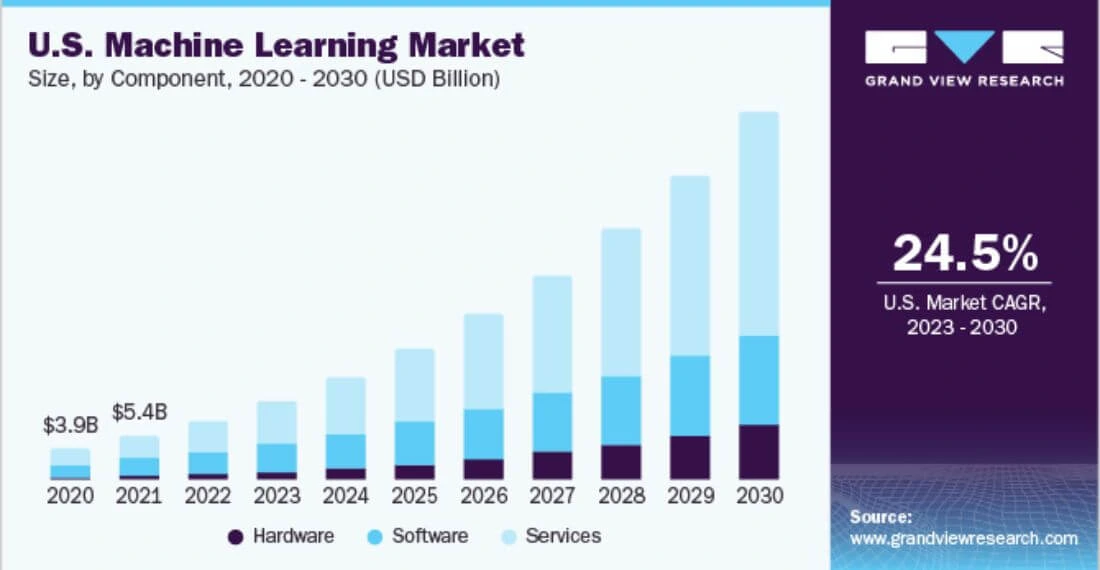
The market for generative AI alone is anticipated to cross $66 billion by 2032, growing at a staggering CAGR of 34.6%. These trends speak volumes about how quickly the industry is adopting both technologies.
Knowledge of these differences allows companies to select the appropriate solution for their needs, whether it’s automation, prediction, personalization, or content generation, and achieve maximum impact across various industries.
Machine Learning (ML) refers to a type of artificial intelligence that allows a machine to make decisions or predictions without being directly programmed.
Machine learning is dependent on algorithms, which are used to process both structured and semi-structured data to carry out functions such as classification, prediction, and optimization.
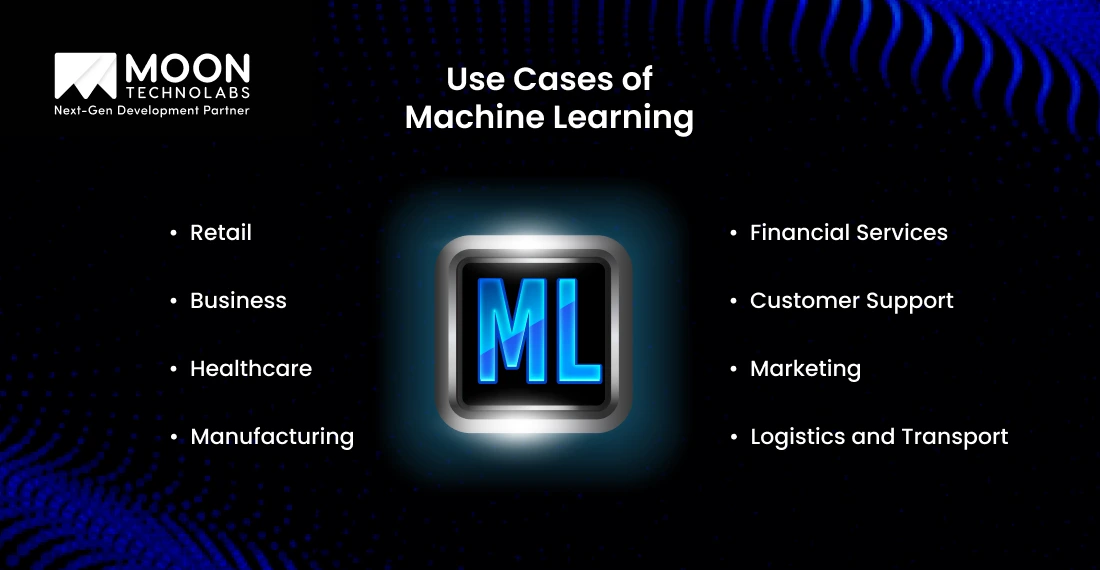
Machine learning helps retail companies suggest products based on customer preferences, such as similar products or customized offers. It also facilitates intelligent inventory management by predicting demand, lowering overstock and stockouts.
In business, ML is used to analyze current conditions and forecast outcomes, such as revenue patterns or performance changes. It also aids fraud detection and risk scoring by studying patterns and anomalies in past data.
Healthcare uses of ML include patient vital monitoring, anomaly detection, and automated health monitoring, and more. It also helps in diagnosing diseases by analyzing medical history and lab test results to offer early alerts.
Machine learning plays a critical role in monitoring manufacturing units, production lines, and overall efficiency. Predictive maintenance also relies on real-time sensor data to predict equipment failure and reduce downtime.
In finance, ML is used to tailor financial plans, enhance fintech security, and detect fraud or suspicious transactions. It also helps automate credit scoring and facilitates loan approval based on customer data analysis.
Machine learning drives chatbots that manage routine customer inquiries, complaints, etc. It also enhances service operations by automatically classifying tickets and directing them to the appropriate department for quicker resolution.
ML enhances marketing activities by analyzing customer behavior for better targeting and increased sales. It facilitates lead scoring and customer segmentation, allowing marketers to target the most viable prospects.
In transportation and logistics, ML helps track vehicles using GPS and optimize routing for efficient delivery. It enhances route planning to make timely deliveries, cut costs, and optimize fleet management.
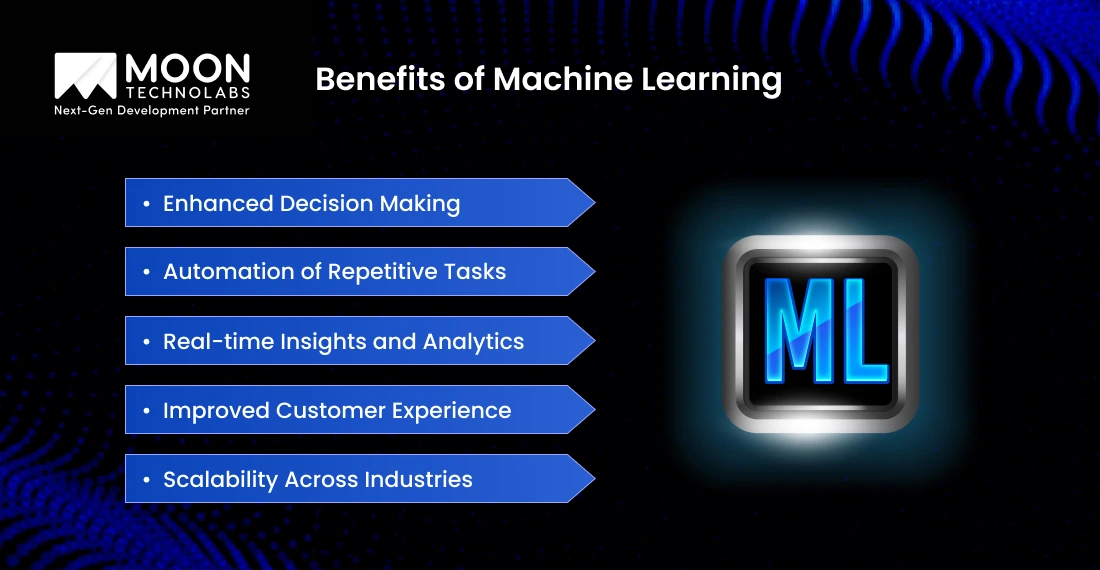
Machine learning facilitates data-driven decision-making by revealing patterns and trends from large datasets. It eliminates human bias and enables businesses to make accurate predictions, leading to improved strategic outcomes.
ML automates repetitive and time-consuming tasks, such as data entry, customer support responses, and report generation. This releases human resources for more complex, creative, or strategic tasks.
Due to its ability to handle large data sets in real-time, ML provides immediate insights. This is particularly applicable in sectors such as finance, healthcare, and retail for timely intervention.
From custom product suggestions to smart chatbots, ML ensures user experiences can be customized. It predicts the user’s needs and enhances engagement, satisfaction, and loyalty.
Machine Learning is a multidisciplinary field that can be applied in various sectors, including retail, healthcare, and manufacturing. Scalability enables startups and enterprises alike to deploy solutions cost-effectively and optimally.
Generative AI is a subfield of artificial intelligence that generates new content, including text, images, music, and video, by learning from large datasets.
It is based on machine learning, particularly deep learning models, to produce outputs that resemble human creativity and decision-making.
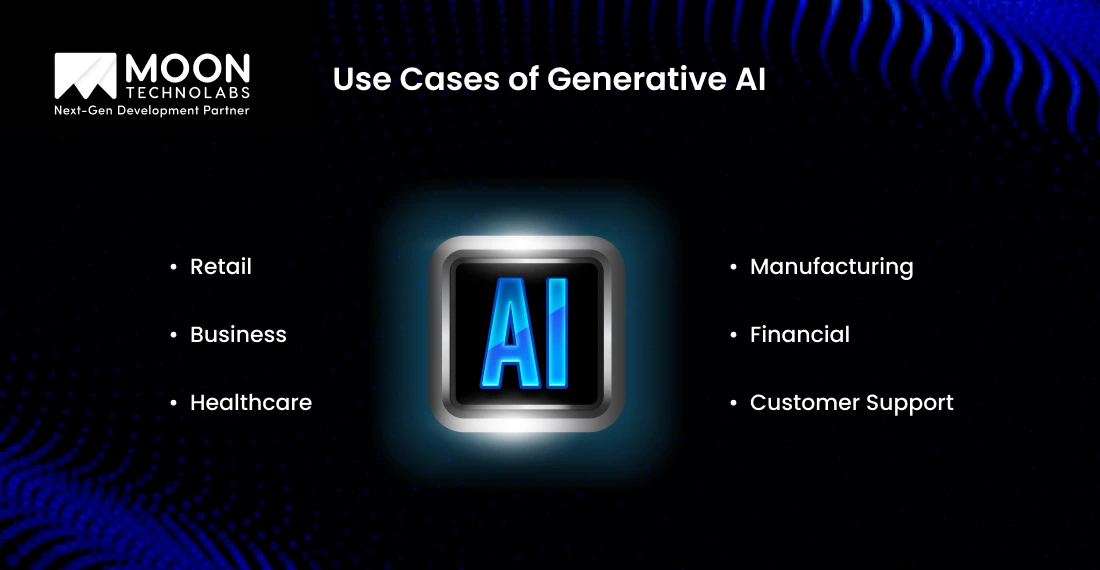
Generative AI is revolutionizing retail by identifying business trends and supporting VR-AR-related activities, such as virtual try-ons, which offer richer shopping experiences. It also helps with dynamic product descriptions and ad creative generation, improving marketing efficiency and effectiveness.
In the corporate world, generative AI can help create internal reports, email drafts, and automation scripts based on just a prompt, enhancing operational efficiency. It also helps simulate business situations for strategic planning, allowing decision-makers to navigate potential outcomes easily.
Generative AI reads doctors’ text, interprets complex medicines, and facilitates personalized patient-based treatment predictions and more.
Moreover, it generates synthetic medical data that helps with research, model training, and the development of privacy-preserving clinical innovations.
In manufacturing, generative AI is applied in supply chain and design related processes, such as blueprint creation and process improvement. It also enhances the virtual simulation of assembly line optimization, reducing errors and increasing productivity.
Generative AI is used to simulate stock market outcomes and produce artificial trading data for testing models. It’s also used to automate the generation of financial reports, as well as scripting customized communications to customers, both of which enhance speed and compliance.
Generative AI recognizes stress and emotion in customer conversations through text or audio inputs. It also auto-generates empathetic responses for chat or email, improving support quality with less agent workload.
You Might Also Like:
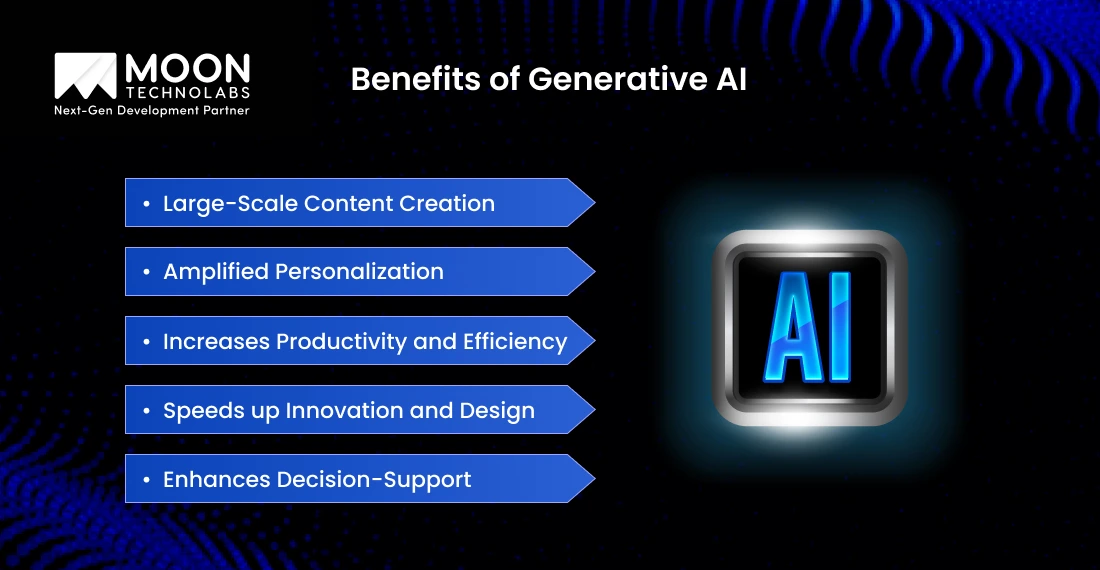
Generative AI can create copious amounts of high-quality content—text, images, video, and beyond—with little to no human input. This speeds up marketing, product documentation, and communication projects across industries.
It powers hyper-personalized user interactions by creating custom responses, suggestions, and deals. This boosts customer satisfaction and engagement in verticals like e-commerce, healthcare, and banking.
Generative AI performs tasks such as report generation, email creation, and data summarization, thus saving time for strategic activities. It minimizes manual labor and turnaround times within departments.
In industries such as manufacturing, construction, and game development, generative AI helps create new design ideas or models. It expedites the creative activity and facilitates experimentation at low costs.
Through simulating different business or financial situations, generative AI helps leaders test “what-if” scenarios. This improves planning, forecasting, and data-driven decision-making.
Generative AI and machine learning employ a range of deep learning models. Each model is best suited for distinct types of tasks based on the structure of the input and output data, as well as the goals. Let’s check it below:
GANs employ two neural networks — a generator and a discriminator — that compete against each other to generate highly realistic synthetic data. They are commonly applied in image generation, deepfakes, and data augmentation in both generative AI and machine learning.
Transformers are central to contemporary generative AI and NLP applications. They operate on input data in parallel, as opposed to recurrent neural networks (RNNs).
They are naturally suitable for sequence-to-sequence applications, including translation, summarization, and driving large language models such as GPT and BERT.
They are used in generative AI to predict the next value in a sequence based on past inputs. They apply text generation, audio production, and picture synthesis, one pixel or word at a time. GPT models are great examples of autoregressive designs.
LLMs, such as ChatGPT, are trained on massive datasets to read and write text that resembles human language. Developed on transformer architecture, they are the foundation of generative AI tools for content generation, code completion, and virtual assistants.
RNNs handle sequential data by retaining contextual information from past inputs, making them suitable for applications such as time-series analysis, speech recognition, and simple text generation. They are predominantly used in ML (i.e., stock forecasting) as well as initial gen AI applications.
Multimodal models blend information from multiple sources, including text, image, video, and audio, to produce more accurate and richer outputs. They’re crucial in applications such as image captioning, video summarization, and AI assistants.
Primarily used in generative AI, diffusion models start with noisy data and learn how to reverse the process of adding noise, producing realistic outputs. DALL-E and Midjourney are tools that use this method to produce high-quality images based on text inputs.
| Aspect | Generative AI | Machine Learning |
|---|---|---|
| Core Function | A machine to solve problems by generating new content or data. | Gives output based on past data and training patterns. |
| Task Execution | Offers autonomy to perform tasks with minimal human intervention. | Learns continuously, improves over time, and delivers better results. |
| Capabilities | Exhibits good capabilities across creative and cognitive tasks. | Works within a narrow assortment of predefined tasks. |
| Decision-Making | Mimics human decision-making to generate realistic outputs. | Uses algorithms to learn from data and make predictions. |
| Data Compatibility | Works with all types of data, including semi-structured and unstructured. | Lacks deep contextual understanding, so struggles with unstructured data. |
| Learning Pattern | Supports automatic self-learning and model refinement. | Adapts based on user feedback and performance data. |
| Use Case Fit | Ideal for static data environments, such as document generation or design. | Best suited for dynamic data applications, such as fraud detection or demand forecasting. |
Get custom AI and Machine Learning solutions tailored to your business needs with Moon Technolabs’ expert development services.
Machine learning and generative AI both contribute differently to the mix. ML excels in pattern analysis, outcome prediction, and decision-making automation with structured data.
Generative AI is opening doors by generating new content and providing dynamic solutions from creative inputs. With changing industries, a fusion of machine learning (ML) and general AI can unlock better automation, innovation, and customer experience.
01
02
03
04
Submitting the form below will ensure a prompt response from us.